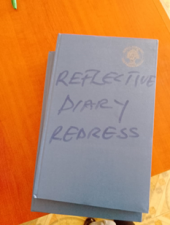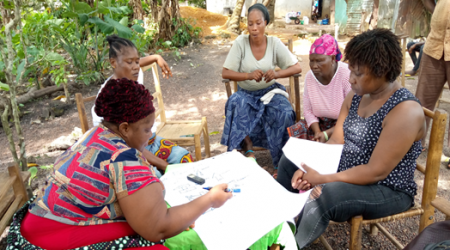By Georgina V. K. Zawolo, John Solunta Smith Jr., Jerry Kollie, Colleen Parker, Hannah Berrian, Wede Tate, Emerson Rogers and Zeela Zaizay
REDRESS started its baseline activities in three counties in April in Lofa, Margibi and Grand Gedeh, the three intervention counties of REDRESS. The baseline will form a key part of the REDRESS evaluation to capture experiences related to health-seeking and participation in the community, relationships and perceptions of various stakeholders before we implement the intervention so that we can evaluate any changes over time. As a team of researchers, we travelled across the country to meet our peer researchers; Hannah and Wede travelled to Margibi, Zeela, Emerson, Colleen and Jerry journeyed to Lofa and Georgina and Smith spent two days driving through bumpy roads to Grand Gedeh, taking in the scenery of beautiful rivers and green forests.
The baseline activities consisted of using multiple qualitative and quantitative methods to engage health workers, traditional healers, community members and persons affected by severe stigmatizing skin diseases. This reflection focuses on using participatory qualitative methods such as social mapping, social network analysis, body mapping, in-depth interviews, photovoice and reflexive diaries to document stories from persons affected and experiences from community members and traditional healers.
Social Network Analysis with Traditional Healers and Faith Healers
We conducted a focus group discussion with traditional healers and faith healers using social network analysis to explore their experience in providing care for people with skin sickness and their relationships with health workers. We did this by using a Venn diagram where we asked participants to draw a circle to represent themselves, then draw a circle to represent health workers, the closer the circles were the stronger the relationship. This visual tool helped to facilitate the discussion, and to determine whether a link currently exists between the informal and formal health system. Traditional healers shared their experience of attending to people affected by various conditions including mental health described in Margibi as “talking out of the head”. They also shared their knowledge and understanding about severe stigmatizing skin diseases (SSSDs) such as Buruli Ulcer, yaws, lymphedema, leprosy, hydrocele, river blindness and their relationship with the hospital or health facilities. While most participants associated SSSDs with witchcraft or tradition beliefs, some also mentioned their beliefs that some conditions, such as leprosy, can be cured through both the hospital and herbalist. It was interesting to hear a mixture of views. These discussions serve as a basis for beginning our REDRESS intervention where we hope to collaborate with traditional and faith healers to improve patient support and referral.


Body mapping
In Grand Gedeh, we conducted body mapping which is a creative method whereby participants are asked to draw an outline of their body and annotate and draw on it to explore thoughts, feelings and experience of their illness. For example, where symptoms started and how it made them feel. We used body mapping with person affected by severe stigmatizing skin diseases and members of the community to understand their knowledge and perception on the causes of SSSDs conditions. As the Grand Gedeh team, we find it worthwhile to mention that the body mapping exercise is very unique and interesting. It allows individuals to explain their story or care seeking journey. It was interesting to listen to the stories of persons affected as they illustrated their thoughts and feelings using the body map. Participants felt very happy and seemed to enjoy doing this exercise. The knowledge gained through the body mapping activities is designed to support us to work with affected persons to monitor how the REDRESS interventions impact their wellbeing and respond to their needs and priorities.

‘As the Grand Gedeh team, we find it worthwhile to mention that the body mapping exercise is very unique and interesting. It allows individuals to explain their story or care seeking journey.’
(Georgina V. K. Zawolo and John Solunta Smith Jr., Grand Gedeh)
Reflective Diaries
The main purpose of a reflective diary is to provide a way to document reflections from health workers at facility and community level, informal providers and peer support group leaders to reflect on their role within REDRESS intervention about supervision and providing care for people affected by skin NTDs. The reflexive diary is a continuous process where individuals will reflect on their engagements with REDRESS and throughout the entire intervention processes. During the baseline, we trained participants in starting their diaries either through writing or recording by first reflecting on their roles and hopes for REDRESS. Participants reflected on their roles and responsibilities in their various facilities and communities, including patient care and treatment, supportive supervisions, community referrals, and awareness on skin NTDs and other diseases. Health workers hopes for the intervention phase included prioritizing patient care, availability of drugs and wound management at health facilities for people affected with skin NTDs; and continuation of trainings on awareness on skin NTDs. In Lofa, we conducted general training with OIC, CHSS, CHAs CHVs for how to reflect, what to write in diary, what questions to reflect upon when doing reflections and gave them a written diary. Due to literacy levels, we conducted general training with faith healers, traditional healers and persons affected about what to reflect upon, using cell phones; they were shown how to record reflections using the phone. They were very excited in learning what reflective diary is all about, because by doing this they said, they feel part of the process. Co-researchers will revisit participants every 2-3 weeks to address any challenges and provide support.

‘They were very excited in learning what reflective diary is all about, because by doing this they said, they feel part of the process.’
(Colleen Parker, Lofa)

Photovoice
We are using photovoice with persons affected to explore what makes access to health services difficult, what makes access to health services easy, thoughts and feelings about skin sickness and how this may change after the roll out of intervention activities. In Margibi, Hannah and Wede used their experience of using photovoice in the formative phase to train persons affected.
‘For REDRESS baseline data collection, it was very interesting to hear that person affected mentioned it is their first time to participate in research using photovoice method. It was also exciting for them to use a smart phone because most of them cannot afford to buy it. They look forward to seeing the outcome of photovoice process.’
(Hannah Berrian, Margibi)
Social Mapping
As part of the evaluation, we used social mapping to understand how affected person participated in social and governance-related activities in their communities so we can monitor how this changes through time. Social mapping was grouped by gender, with social maps drawn by women and men. Participants were asked to draw a map of their communities and discuss their level of participation in different areas. Both men and women groups were able to draw the community map with structures, for example, mosque, church, clinic, palava hut, school. Participants included different levels of literacy however, they could draw their community maps and label structures themselves. Across counties, we found that many persons affected noted that they were not involved in social gatherings except attending church services due to their conditions.
For Jerry in Lofa, the most interesting method was Social Mapping where one 65-year-old woman affected by Buruli ulcer mentioned it was the first time she had held a pencil in her life. It was also interesting in that, almost all of the participants (the women) were elderly people between the ages of 40 – 65 years, who are or have been opinion leaders in their communities and were able to provide their stories of how their present conditions have influenced the way community members to relate to them.

‘A considerable number of participants for our social mapping session were illiterate. One of them said, From the time that I was born, this is my first time holding a pencil". She was happy that REDRESS made an unintended change in her life.’
(Zeela Zaizay, Lofa )
Lessons learned and Conclusion
Doing qualitative methods was very interesting, we learned a lot about the diversity, different literacy levels, and cultural differences among and between participants. The methods conducted – FGDs with Faith Healers, In-depth interviews, and Social Mapping with Persons Affected unveiled a lot of very important and hidden information that would not have been known had we not conducted the methods. Affected persons experiences of how and when they encountered the diseases, how they are being treated by family and community members, as well as their perspectives about the care provided by healthcare providers at healthcare facilities, and the different treatment pathways from the inception of their conditions are worth knowing as they help in making critical decisions about how we adapt and learn from REDRESS interventions.
Jerry, as part of team Lofa, explained the importance of building a rapport and showing empathy and respect when working with vulnerable groups as a researcher, particularly during participatory methods.
‘Though the methods were time-consuming and needed someone with love for the people as was demonstrated by us, they were worth conducting and have provided a lot of information.’
(Jerry Kollie, Lofa)
- We found that inclusion of affected persons or patients into the FGDs boost their confidence levels to engage formal care seeking journeys via the hospital.
- The interactions of patients among themselves promotes learning and derived strong support amongst themselves.
- We also found that the involvement of community leaders into the FGDs shape the community leaders thinking about people with SSSDs and their inclusion into social and governance activities.
‘The interactions of patients among themselves promotes learning and derived strong support amongst themselves.
(Georgina V. K. Zawolo, Grand Gedeh)
These participatory methods helped our participants to freely express themselves and make them feel a part of research activity. As a result of engaging affected persons through these methods, it gave them the opportunity to make decisions about their health seeking behaviour. Strong collaboration with the community is critical to the identification, referral and treatment of people affected with severe stigmatizing skin diseases. In conclusion, our data collection was exciting with many rewarding experiences. We look forward to now analysing the baseline and working to progress the evaluation.
With acknowledgement and thanks to our peer researchers:
Margibi County: Christopher Morris, Haggar M. Kurah., Grand Gedeh County: Amanda Hallowanger, G. Robert Jaffa.,Lofa County: Satta Kollie, Emmanuel G. Zaizay, Jallah Kesselee and Kebeh W.Lavela